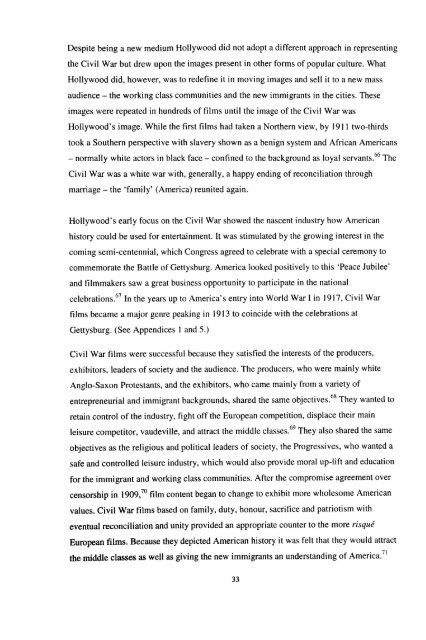Download (3483kB) - Greenwich Academic Literature Archive ...
Download (3483kB) - Greenwich Academic Literature Archive ...
Download (3483kB) - Greenwich Academic Literature Archive ...
- No tags were found...
You also want an ePaper? Increase the reach of your titles
YUMPU automatically turns print PDFs into web optimized ePapers that Google loves.
Despite being a new medium Hollywood did not adopt a different approach in representingthe Civil War but drew upon the images present in other forms of popular culture. WhatHollywood did, however, was to redefine it in moving images and sell it to a new massaudience - the working class communities and the new immigrants in the cities. Theseimages were repeated in hundreds of films until the image of the Civil War wasHollywood's image. While the first films had taken a Northern view, by 1911 two-thirdstook a Southern perspective with slavery shown as a benign system and African Americans- normally white actors in black face - confined to the background as loyal servants. 66 TheCivil War was a white war with, generally, a happy ending of reconciliation throughmarriage - the 'family' (America) reunited again.Hollywood's early focus on the Civil War showed the nascent industry how Americanhistory could be used for entertainment. It was stimulated by the growing interest in thecoming semi-centennial, which Congress agreed to celebrate with a special ceremony tocommemorate the Battle of Gettysburg. America looked positively to this 'Peace Jubilee'and filmmakers saw a great business opportunity to participate in the nationalcelebrations.67 In the years up to America's entry into World War I in 1917, Civil Warfilms became a major genre peaking in 1913 to coincide with the celebrations atGettysburg. (See Appendices 1 and 5.)Civil War films were successful because they satisfied the interests of the producers,exhibitors, leaders of society and the audience. The producers, who were mainly whiteAnglo-Saxon Protestants, and the exhibitors, who came mainly from a variety ofentrepreneurial and immigrant backgrounds, shared the same objectives. They wanted toretain control of the industry, fight off the European competition, displace their mainleisure competitor, vaudeville, and attract the middle classes. 69 They also shared the sameobjectives as the religious and political leaders of society, the Progressives, who wanted asafe and controlled leisure industry, which would also provide moral up-lift and educationfor the immigrant and working class communities. After the compromise agreement overcensorship in 1909,70 film content began to change to exhibit more wholesome Americanvalues. Civil War films based on family, duty, honour, sacrifice and patriotism witheventual reconciliation and unity provided an appropriate counter to the more risqueEuropean films. Because they depicted American history it was felt that they would attractthe middle classes as well as giving the new immigrants an understanding of America. 71f Q33
















